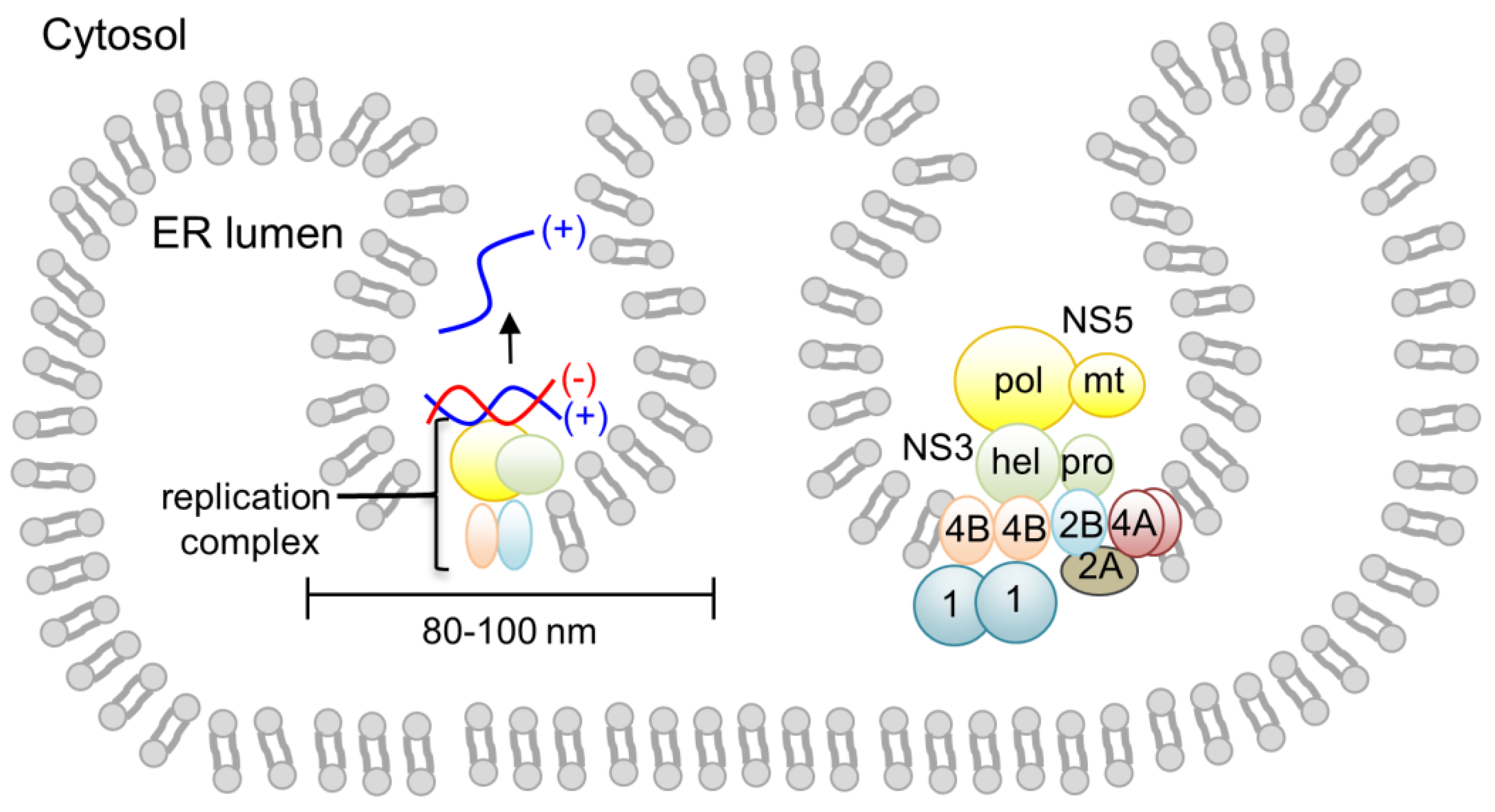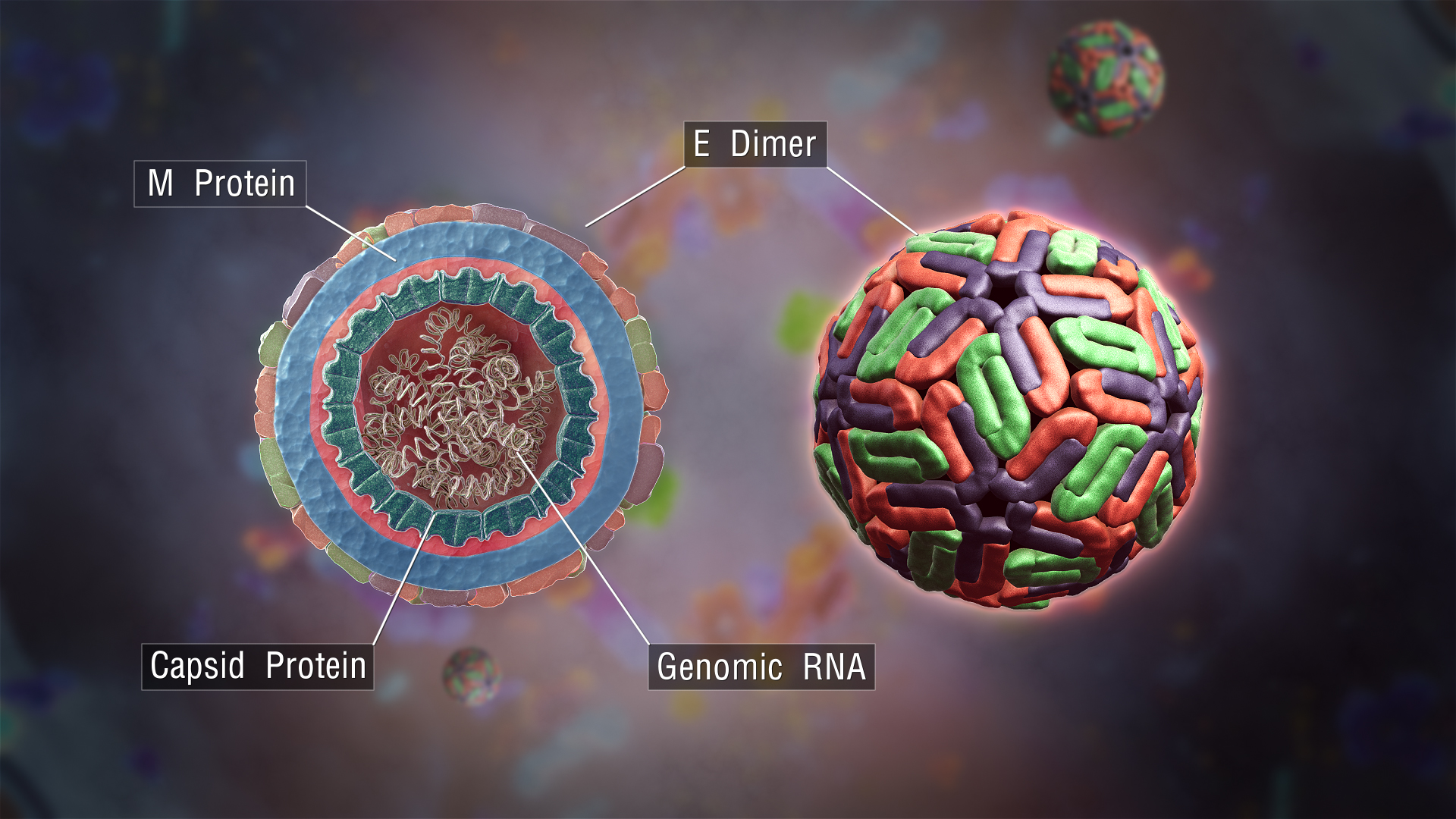|
Flaviviridae
''Flaviviridae'' is a family of enveloped positive-strand RNA viruses which mainly infect mammals and birds. They are primarily spread through arthropod vectors (mainly ticks and mosquitoes). The family gets its name from the yellow fever virus; ''flavus'' is Latin for "yellow", and yellow fever in turn was named because of its propensity to cause jaundice in victims. There are 89 species in the family divided among four genera. Diseases associated with the group include: hepatitis (hepaciviruses), hemorrhagic syndromes, fatal mucosal disease (pestiviruses), hemorrhagic fever, encephalitis, and the birth defect microcephaly (flaviviruses). Structure Virus particles are enveloped and spherical with icosahedral-like geometries that have pseudo T=3 symmetry. They are about 40–60 nm in diameter. Genome Members of the family ''Flaviviridae'' have monopartite, linear, single-stranded RNA genomes of positive polarity, and 9.6 to 12.3 kilobase in total length. The 5'-termini of ... [...More Info...] [...Related Items...] OR: [Wikipedia] [Google] [Baidu] |
Pegivirus
''Pegivirus'' is the approved name for a genus of single positive-stranded RNA viruses in the family ''Flaviviridae''. The name is a derived one: "Pe" stands for "persistent" and "g" is a reference to Hepatitis G, a former name of the ''C'' species. Taxonomy Eleven named species are within the genus ''Pegivirus''. Isolates belonging to the species ''Pegivirus C'' are monophyletic and show 50% nucleotide (>55% amino acid) divergence from other members of this genus. Pegiviruses assigned to this species (''Pegivirus A'') originate from primate host species (humans, chimpanzees and several New World monkey species). The sequence U22303 has been assigned as the type member of the species, as this was the first pegivirus to be described for this species. Terminology to describe viruses with different hosts has not been approved by the International Committee on Taxonomy of Viruses; however, ''Pegivirus A'' viruses have been called HPgV for human pegivirus, SPgV for new world simia ... [...More Info...] [...Related Items...] OR: [Wikipedia] [Google] [Baidu] |
Hepacivirus
''Hepacivirus'' is a genus of positive-strand RNA viruses in the family ''Flaviviridae''. The hepatitis C virus (HCV), in species ''Hepacivirus C'', infects humans and is associated with hepatitis and hepatocellular carcinoma. There are fourteen species in the genus which infect a range of other vertebrate. History Hepatitis C virus (HCV), which is the causative agent of hepatitis C in humans, and a member of the species ''Hepacivirus C'', was discovered in 1989. Seven genotypes (1–7) and eighty-six subtypes (1a, 1b etc.) of hepatitis C virus have been named. GBV-B virus (also known as GB virus B) discovered in 1995 is capable of infecting New World monkeys, in particular tamarins. Like HCV it is transmitted by the blood-borne route and similar to HCV it is associated with the viral hepatitis. However GBV-B has never been identified in wild animals and its natural host is not known. Structure Viruses in the genus ''Hepacivirus'' are enveloped and have spherical icosahedral-li ... [...More Info...] [...Related Items...] OR: [Wikipedia] [Google] [Baidu] |
Hepacivirus
''Hepacivirus'' is a genus of positive-strand RNA viruses in the family ''Flaviviridae''. The hepatitis C virus (HCV), in species ''Hepacivirus C'', infects humans and is associated with hepatitis and hepatocellular carcinoma. There are fourteen species in the genus which infect a range of other vertebrate. History Hepatitis C virus (HCV), which is the causative agent of hepatitis C in humans, and a member of the species ''Hepacivirus C'', was discovered in 1989. Seven genotypes (1–7) and eighty-six subtypes (1a, 1b etc.) of hepatitis C virus have been named. GBV-B virus (also known as GB virus B) discovered in 1995 is capable of infecting New World monkeys, in particular tamarins. Like HCV it is transmitted by the blood-borne route and similar to HCV it is associated with the viral hepatitis. However GBV-B has never been identified in wild animals and its natural host is not known. Structure Viruses in the genus ''Hepacivirus'' are enveloped and have spherical icosahedral-li ... [...More Info...] [...Related Items...] OR: [Wikipedia] [Google] [Baidu] |
Flavivirus
''Flavivirus'' is a genus of positive-strand RNA viruses in the family ''Flaviviridae''. The genus includes the West Nile virus, dengue virus, tick-borne encephalitis virus, yellow fever virus, Zika virus and several other viruses which may cause encephalitis, as well as insect-specific flaviviruses (ISFs) such as cell fusing agent virus (CFAV), Palm Creek virus (PCV), and Parramatta River virus (PaRV). While dual-host flaviviruses can infect vertebrates as well as arthropods, insect-specific flaviviruses are restricted to their competent arthropods. The means by which flaviviruses establish persistent infection in their competent vectors and cause disease in humans depends upon several virus-host interactions, including the intricate interplay between flavivirus-encoded immune antagonists and the host antiviral innate immune effector molecules. Flaviviruses are named for the yellow fever virus; the word ''flavus'' means 'yellow' in Latin, and yellow fever in turn is named from i ... [...More Info...] [...Related Items...] OR: [Wikipedia] [Google] [Baidu] |
Flavivirus
''Flavivirus'' is a genus of positive-strand RNA viruses in the family ''Flaviviridae''. The genus includes the West Nile virus, dengue virus, tick-borne encephalitis virus, yellow fever virus, Zika virus and several other viruses which may cause encephalitis, as well as insect-specific flaviviruses (ISFs) such as cell fusing agent virus (CFAV), Palm Creek virus (PCV), and Parramatta River virus (PaRV). While dual-host flaviviruses can infect vertebrates as well as arthropods, insect-specific flaviviruses are restricted to their competent arthropods. The means by which flaviviruses establish persistent infection in their competent vectors and cause disease in humans depends upon several virus-host interactions, including the intricate interplay between flavivirus-encoded immune antagonists and the host antiviral innate immune effector molecules. Flaviviruses are named for the yellow fever virus; the word ''flavus'' means 'yellow' in Latin, and yellow fever in turn is named from i ... [...More Info...] [...Related Items...] OR: [Wikipedia] [Google] [Baidu] |
Pestivirus
''Pestivirus'' is a genus of viruses, in the family ''Flaviviridae''. Viruses in the genus ''Pestivirus'' infect mammals, including members of the family Bovidae (which includes cattle, sheep, and goats) and the family Suidae (which includes various species of swine). There are 11 species in this genus. Diseases associated with this genus include: hemorrhagic syndromes, abortion, and fatal mucosal disease. Structure Viruses in ''Pestivirus'' are enveloped, with spherical geometries. Their diameter is around 50 nm. Genomes are linear and not segmented, around 12kb in length. Lifecycle Entry into the host cell is achieved by attachment of the viral envelope protein E2 to host receptors, which mediates clathrin-mediated endocytosis. The main viral replication process happens in host cytoplasm. Replication follows the Positive-strand RNA virus, positive strand RNA virus replication model. An Internal ribosome entry site, IRES RNA element at the 5'-nontranslated region (NTR) ... [...More Info...] [...Related Items...] OR: [Wikipedia] [Google] [Baidu] |
Pestivirus
''Pestivirus'' is a genus of viruses, in the family ''Flaviviridae''. Viruses in the genus ''Pestivirus'' infect mammals, including members of the family Bovidae (which includes cattle, sheep, and goats) and the family Suidae (which includes various species of swine). There are 11 species in this genus. Diseases associated with this genus include: hemorrhagic syndromes, abortion, and fatal mucosal disease. Structure Viruses in ''Pestivirus'' are enveloped, with spherical geometries. Their diameter is around 50 nm. Genomes are linear and not segmented, around 12kb in length. Lifecycle Entry into the host cell is achieved by attachment of the viral envelope protein E2 to host receptors, which mediates clathrin-mediated endocytosis. The main viral replication process happens in host cytoplasm. Replication follows the Positive-strand RNA virus, positive strand RNA virus replication model. An Internal ribosome entry site, IRES RNA element at the 5'-nontranslated region (NTR) ... [...More Info...] [...Related Items...] OR: [Wikipedia] [Google] [Baidu] |
Yellow Fever
Yellow fever is a viral disease of typically short duration. In most cases, symptoms include fever, chills, loss of appetite, nausea, muscle pains – particularly in the back – and headaches. Symptoms typically improve within five days. In about 15% of people, within a day of improving the fever comes back, abdominal pain occurs, and liver damage begins causing yellow skin. If this occurs, the risk of bleeding and kidney problems is increased. The disease is caused by the yellow fever virus and is spread by the bite of an infected mosquito. It infects humans, other primates, and several types of mosquitoes. In cities, it is spread primarily by ''Aedes aegypti'', a type of mosquito found throughout the tropics and subtropics. The virus is an RNA virus of the genus ''Flavivirus''. The disease may be difficult to tell apart from other illnesses, especially in the early stages. To confirm a suspected case, blood-sample testing with polymerase chain reaction is required. A saf ... [...More Info...] [...Related Items...] OR: [Wikipedia] [Google] [Baidu] |
Dengue Virus
''Dengue virus'' (DENV) is the cause of dengue fever. It is a mosquito-borne, single positive-stranded RNA virus of the family ''Flaviviridae''; genus ''Flavivirus''. Four serotypes of the virus have been found, a reported fifth has yet to be confirmed,Dwivedi, V. D., Tripathi, I. P., Tripathi, R. C., Bharadwaj, S., & Mishra, S. K. (2017). Genomics, proteomics and evolution of ''Dengue virus''. Briefings in functional genomics.16(4): 217–227, https://doi.org/10.1093/bfgp/elw040 all of which can cause the full spectrum of disease. Nevertheless, scientists' understanding of dengue virus may be simplistic as, rather than distinct antigenic groups, a ''continuum'' appears to exist. This same study identified 47 strains of ''dengue virus''. Additionally, coinfection with and lack of rapid tests for ''zika virus'' and ''chikungunya'' complicate matters in real-world infections. ''Dengue virus'' has increased dramatically within the last 20 years, becoming one of the worst mosquito- ... [...More Info...] [...Related Items...] OR: [Wikipedia] [Google] [Baidu] |
Bovine Viral Diarrhea
Bovine viral diarrhea (BVD), bovine viral diarrhoea (UK English) or mucosal disease, and previously referred to as bovine virus diarrhea (BVD), is an economically significant disease of cattle that is found in the majority of countries throughout the world. Worldwide reviews of the economically assessed production losses and intervention programs (e.g. eradication programs, vaccination strategies and biosecurity measures) incurred by BVD infection have been published. The causative agent, bovine viral diarrhea virus (BVDV), is a member of the genus ''Pestivirus'' of the family Flaviviridae. BVD infection results in a wide variety of clinical signs, due to its immunosuppressive effects, as well as having a direct effect on respiratory disease and fertility. In addition, BVD infection of a susceptible dam during a certain period of gestation can result in the production of a persistently infected (PI) fetus. PI animals recognise intra-cellular BVD viral particles as ‘self’ and ... [...More Info...] [...Related Items...] OR: [Wikipedia] [Google] [Baidu] |
Zika Virus
''Zika virus'' (ZIKV; pronounced or ) is a member of the virus family ''Flaviviridae''. It is spread by daytime-active ''Aedes'' mosquitoes, such as '' A. aegypti'' and '' A. albopictus''. Its name comes from the Ziika Forest of Uganda, where the virus was first isolated in 1947. ''Zika virus'' shares a genus with the dengue, yellow fever, Japanese encephalitis, and West Nile viruses. Since the 1950s, it has been known to occur within a narrow equatorial belt from Africa to Asia. From 2007 to , the virus spread eastward, across the Pacific Ocean to the Americas, leading to the 2015–2016 Zika virus epidemic. The infection, known as Zika fever or ''Zika virus'' disease, often causes no or only mild symptoms, similar to a very mild form of dengue fever. While there is no specific treatment, paracetamol (acetaminophen) and rest may help with the symptoms. Zika can spread from a pregnant woman to her baby. This can result in microcephaly, severe brain malformations, and o ... [...More Info...] [...Related Items...] OR: [Wikipedia] [Google] [Baidu] |
Viral Hemorrhagic Fever
Viral hemorrhagic fevers (VHFs) are a diverse group of animal and human illnesses in which fever and hemorrhage are caused by a viral infection. VHFs may be caused by five distinct families of RNA viruses: the families ''Filoviridae'', ''Flaviviridae'', ''Rhabdoviridae'', and several member families of the ''Bunyavirales'' order such as '' Arenaviridae'', and ''Hantaviridae''. All types of VHF are characterized by fever and bleeding disorders and all can progress to high fever, shock and death in many cases. Some of the VHF agents cause relatively mild illnesses, such as the Scandinavian '' nephropathia epidemica'' (a hantavirus), while others, such as Ebola virus, can cause severe, life-threatening disease. Signs and symptoms Signs and symptoms of VHFs include (by definition) fever and bleeding: * Flushing of the face and chest, small red or purple spots (petechiae), bleeding, swelling caused by edema, low blood pressure (hypotension), and circulatory shock. * Malaise, muscle ... [...More Info...] [...Related Items...] OR: [Wikipedia] [Google] [Baidu] |








.png)